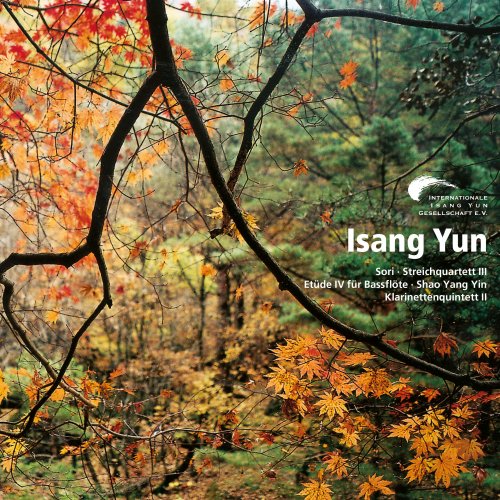Various Artists - Isang Yun: Works, Vol. 6 (2022)

Artist: Various Artists
Title: Isang Yun: Works, Vol. 6
Year Of Release: 2007/2022
Label: Internationale Isang Yun Gesellschaft e.V.
Genre: Classical
Quality: FLAC (tracks+booklet)
Total Time: 64:23 min
Total Size: 279 MB
WebSite: Album Preview
Tracklist:Title: Isang Yun: Works, Vol. 6
Year Of Release: 2007/2022
Label: Internationale Isang Yun Gesellschaft e.V.
Genre: Classical
Quality: FLAC (tracks+booklet)
Total Time: 64:23 min
Total Size: 279 MB
WebSite: Album Preview
1. Sori
2. I. Moderato
3. II. Adagio
4. III. Allegro
5. Étude IV for Solo Flute
6. Shao Yang Yin
7. I. —
8. II. —
9. III. —
The list of Isang Yun’s compositions has been arranged according to genres and instrumentation sizes. Within these categories, the arrangement is as chronological as possible.
For the first time the work titles are preceded by work numbers. These refer exclusively to the official œuvre that was composed in Europe. Number 1 was thus assigned for the Five Pieces for Piano (1958), although we know that numerous compositions preceded this work (compositions until 1958).
The connections between independent works have been usually made clear by so-called annotations to the respective work entry. In some cases, Yun took some bars out of a existing composition that served to create valid new works. These refers to the choirs Ein Schmetterlingstraum (1968-69), Vom Tao (1972/82), the Trio for Flute (Alto Flute), Oboe and Violin (1972-73), the alto flute solo Solomon (1977-78) and the Monologue for bass clarinet (1983, more precisely: 1981-83), but also to the Duo for oboe and harp Kleines Doppelkonzert [Small Double Concerto] (1977/88).
Only in very few cases were a and b numbers assigned. This is the case with edits like the different Gagok versions (27, 27a, 27b). Furthermore, connections between independent works were underlined by the assignment of a-numbers, for example in the case of the Quartet with Intermezzo (85 and 85a; 1988) or in the case of Yun’s last composition at all, the Epilogue for women’s choir and five instruments, which can also be performed separately, and which must conclude the orchestral piece Engel in Flammen / Angel in Flames (1994) according to Yun’s wish and last will (112 and 112a).
Only some of the early works written in Korea have been included here, especially when printed editions are (or were) available. Not mentioned here is an edition financed by MBC Masan for the Tongyeong Music Festival 2003, which contains the Five Songs re-released in the 1990s, a 1951 song Naktonggang (not to be confused with the film music suite of the same name), ten school anthems, a university anthem, and five children’s songs (“The Ttaria Girl”, “The Baby Bell”, “Little Soldier Goes Out”, “The Owl”, “Graduation Day”) by Isang Yun.
Another volume of 58 children’s and school songs (including 47 songs for school use) was published by the Tongyeong Cultural Center in December 2017.
For the first time the work titles are preceded by work numbers. These refer exclusively to the official œuvre that was composed in Europe. Number 1 was thus assigned for the Five Pieces for Piano (1958), although we know that numerous compositions preceded this work (compositions until 1958).
The connections between independent works have been usually made clear by so-called annotations to the respective work entry. In some cases, Yun took some bars out of a existing composition that served to create valid new works. These refers to the choirs Ein Schmetterlingstraum (1968-69), Vom Tao (1972/82), the Trio for Flute (Alto Flute), Oboe and Violin (1972-73), the alto flute solo Solomon (1977-78) and the Monologue for bass clarinet (1983, more precisely: 1981-83), but also to the Duo for oboe and harp Kleines Doppelkonzert [Small Double Concerto] (1977/88).
Only in very few cases were a and b numbers assigned. This is the case with edits like the different Gagok versions (27, 27a, 27b). Furthermore, connections between independent works were underlined by the assignment of a-numbers, for example in the case of the Quartet with Intermezzo (85 and 85a; 1988) or in the case of Yun’s last composition at all, the Epilogue for women’s choir and five instruments, which can also be performed separately, and which must conclude the orchestral piece Engel in Flammen / Angel in Flames (1994) according to Yun’s wish and last will (112 and 112a).
Only some of the early works written in Korea have been included here, especially when printed editions are (or were) available. Not mentioned here is an edition financed by MBC Masan for the Tongyeong Music Festival 2003, which contains the Five Songs re-released in the 1990s, a 1951 song Naktonggang (not to be confused with the film music suite of the same name), ten school anthems, a university anthem, and five children’s songs (“The Ttaria Girl”, “The Baby Bell”, “Little Soldier Goes Out”, “The Owl”, “Graduation Day”) by Isang Yun.
Another volume of 58 children’s and school songs (including 47 songs for school use) was published by the Tongyeong Cultural Center in December 2017.

![Clifton Chenier - Clifton Chenier and His Red Hot Louisiana Band (1978) [Hi-Res] Clifton Chenier - Clifton Chenier and His Red Hot Louisiana Band (1978) [Hi-Res]](https://img.israbox.com/img/2025-12/20/u7c9mz3puf20w5rxo6nmae80o.jpg)

![Enrico Zanisi - Blend Pages (2025) [Hi-Res] Enrico Zanisi - Blend Pages (2025) [Hi-Res]](https://www.dibpic.com/uploads/posts/2022-12/1670308427_enrico-zanisi-blend-pages-2018.jpg)
![The Mood Mosaic - Acid Maestro (Morricone's Cosmic Funk Legacy) (2025) [Hi-Res] The Mood Mosaic - Acid Maestro (Morricone's Cosmic Funk Legacy) (2025) [Hi-Res]](https://www.dibpic.com/uploads/posts/2025-12/1766134708_dkymenaq6pxqa_600.jpg)

![Leslie Baron - In Jest (2025) [Hi-Res] Leslie Baron - In Jest (2025) [Hi-Res]](https://img.israbox.com/img/2025-12/18/2sqpj360q2wy5vki1452chspo.jpg)

